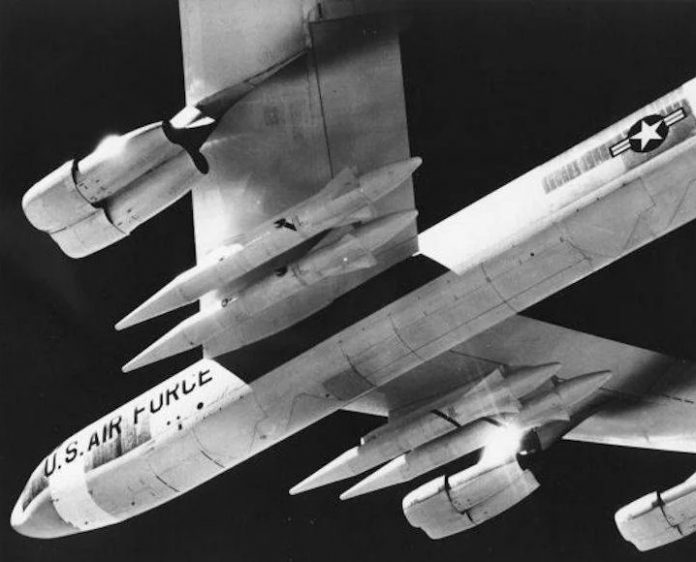
In the late fifties, the US military and the scientists developed and tested two experimental ballistic airborne missile. Products program WS-199 proved the possibility of establishing such weapons, but their own characteristics were far from desirable. For this reason, Bold designs and Orion High Virgo closed, but on the basis of developments began to design a new missile. In different periods of these weapons from Douglas company bore the name WS-138A, GAM-87, AGM-48 и Skybolt.
In the second half of the fifties, the US Air Force faced some difficulties in the area of intercontinental ballistic missiles, what made them pay more attention to air weapons. As part of the Weapon System Program 199 two promising aeroballistic missiles were created for existing bombers. However, the range of products of flight WS-199B Bold Orion and WS-199C High Virgo was 1100 and 300 km respectively - less, than was required to deal effectively with combat missions and engage targets on the territory of a potential enemy, veiled powerful defense.
By the early sixties, Air Force Command, see results, It decided to abandon the experimental samples in favor of a completely new missile, created using their ideas and solutions. Already at the beginning 1959 year there was an order for the design of such weapons. Soon, the main contractor was selected - a contract to develop the rocket got Douglas Aircraft Company. curious, it had previously not participated in the WS-199 program, but its version of the new project seemed most apt.
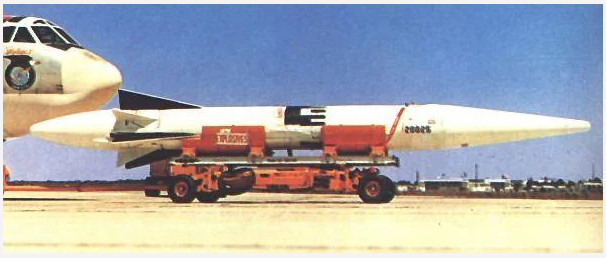 Rocket WS-138A / GAM-87 on the transport trolley.
Rocket WS-138A / GAM-87 on the transport trolley.
Initially, the project was given a faceless designation WS-138A or Weapon System 138A («« 138A »System arms). Later, there were army designation GAM-87 and name Skybolt. After the introduction of new nomenclature missile arms have entered designation AGM-48. Also at the testing stage experimental rocket designated as XGAM-87 or XAGM-48. Letter «X» indicates the current stage of the project.
AT 1959-60 years - long before the actual launch - Skybolt products were the subject of the export contract. During this period, Britain was faced with serious difficulties in the development of ballistic missile Blue Streak. After a lengthy debate the British military and political leadership decided to abandon such weapons. Instead own ballistic missile nuclear forces was planned to strengthen the products WS-138A American production. In March 1960 , countries agreed to supply 144 missiles. The first contract for a batch of 100 products signed in two months.
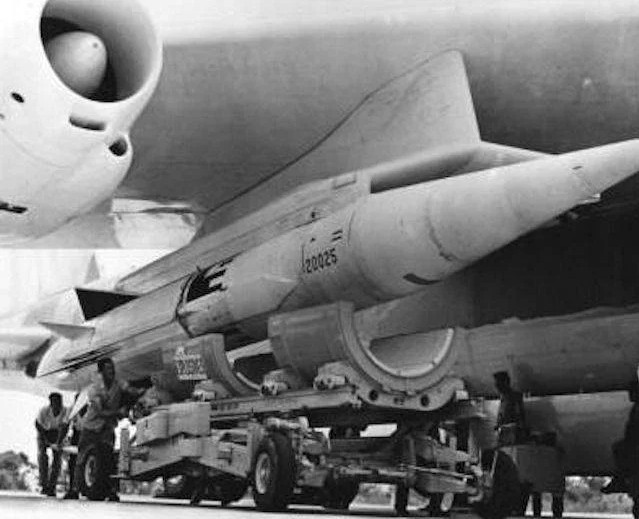 Suspension Skybolt missiles at the carrier.
Suspension Skybolt missiles at the carrier.
The future shape of the rocket WS-138A was determined taking into account developments on the WS-199 program. The most successful have considered two stage scheme using only solid engines. Missile nuclear warheads were asked to complete a high power, size and weight which conform to its capabilities. Inertial navigation system, traditional ballistic missiles that time, intended to supplement astrocorrection means, which allowed to increase the accuracy of shooting.
The main element of the WS-138A missile was a metal housing, built on the basis of the frame. Housing equipped with a long tapered nose cone with a rounded nose section. In the early stages of the test was also used with short fairing cone and the cylindrical wall of small diameter. The main body, Divided into two stages, I had a cylindrical shape with several longitudinal housings protruding on the outer surface. In the tail of the missile has eight planes of triangular shape. Larger sagittal plane functions performed stabilizers. Placed therebetween rotary aerodynamic control surfaces, are smaller. The tail section of the body during the flight on the pole was covered by the media resettable fairing ogival shape. Steps, head portion and fairing connected to each other by means of explosive bolts.
The missile did not differ a complex layout. Volumes within the fairing were given for the installation of the warhead and control systems. All other sections of both stages housed a pair of large solid fuel engines. In the tail portion of the first stage, On the plane level, also located servos.
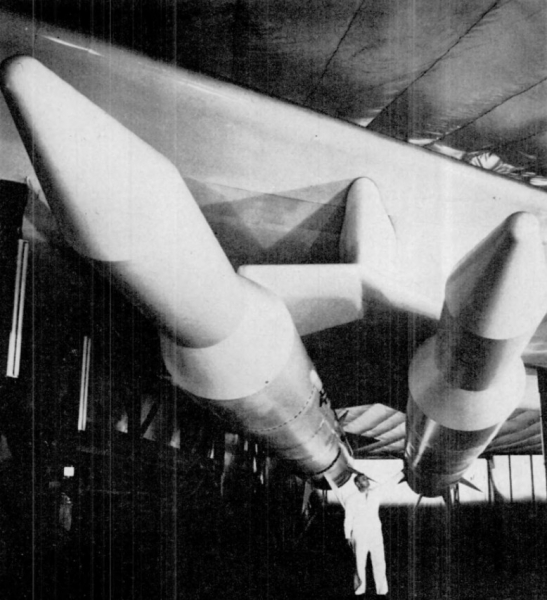 prototypes, which were worked optimum shape fairing.
prototypes, which were worked optimum shape fairing.
The power plant for Skybolt rocket was developed by Aerojet. For the first stage engine developed XM-80, for the second - XM-81. Unlike previous projects, this time the engines are not borrowed from existing missiles, but specifically designed for the new product in accordance with the request.
Northrop has been appointed as a subcontractor, responsible for the creation and production of guidance systems. On the basis of new developments inertial navigation system was developed, integrated into the autopilot. To increase the accuracy of shooting for the first time in American practice has been used astrokorrektor. Manage in-flight offered to carry out a variety of ways. The first stage was equipped with aerodynamic control surfaces, whereas the second movable motor nozzle was used, variable thrust vectoring.
In the basic configuration, designed for the US Air Force, rocket WS-138A was to carry a thermonuclear warhead type W59. This product has a length 1,2 m with a maximum diameter 415 mm and weighed about 250 kg. Its thickness was determined at the level of the charge 1 Mt. Especially for the new missile company General Electric developed a new body with the means to protect combat unit from external influences during the descent to the goal.
British military wanted to buy missiles from other fighting equipment. In their case Skybolt missiles should complete thermonuclear charge type Red Snow capacity 1,1 Mt. This product is different from the US W59, but it did not require major revisions delivery vehicle. A large mass of alternative warhead should have led to a serious loss of flight distance. However, The calculation shows, and it is possible to solve certain combat missions.
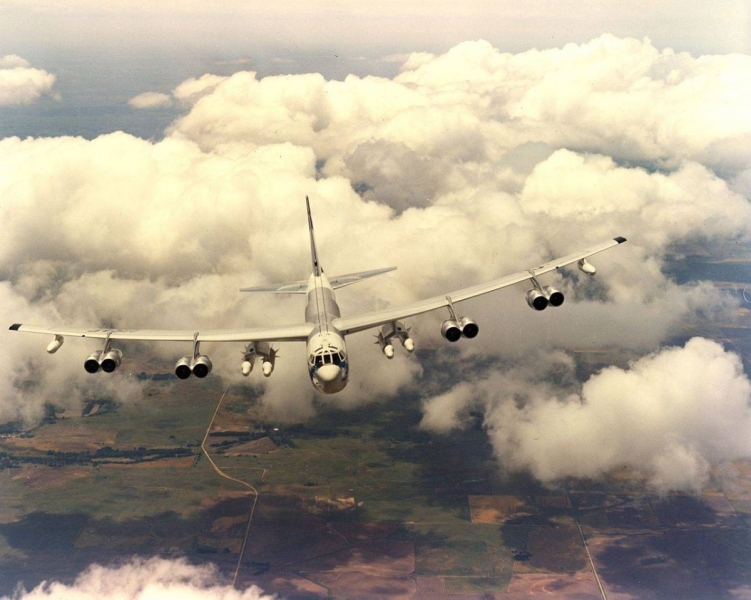 B-52 bomber with four missiles GAM-87 under the wing.
B-52 bomber with four missiles GAM-87 under the wing.
Rocket WS-138A in the transport position, had a total length (including the drop tail fairing) slightly less 11,7 m. Case Diameter - 890 mm. Swipe stabilizers - 1,68 m. Launch weight was determined 11 thousand. pounds - a little less 5 t. according to the calculations, in flight the rocket was to develop a high speed, provided that the flight of a ballistic trajectory to a considerable distance. In the basic configuration, it could send a "light" on the warhead 1850 km. Firing range with Red Snow warhead was reduced to 970 km. However, the British military have counted, that in this case the bomber carrier able to attack Moscow, without entering the airspace of the USSR.
prospective missile main carrier was to be a long-range bomber Boeing B-52G Stratofortress. Oversized missile could only be transported on external sling. On pylons under the center could accommodate up to four missiles. Also studied the possibility of inclusion of rocket WS-138A in the nomenclature of weapons bombers B-58 Hustler and XB-70 Valkyrie.
The Royal Air Force of Great Britain the new missiles were used by the bombers V-Series. Already during the design, it became clear, that the support of WS-138A could be the only one of the three existing aircraft. The rocket was placed just under the bottom of the bomber Avro Vulcan. In the case of machines Vickers Valiant and Handley Page Victor «ground clearance" under the gun turned out to be insufficient, which could lead to accidents.
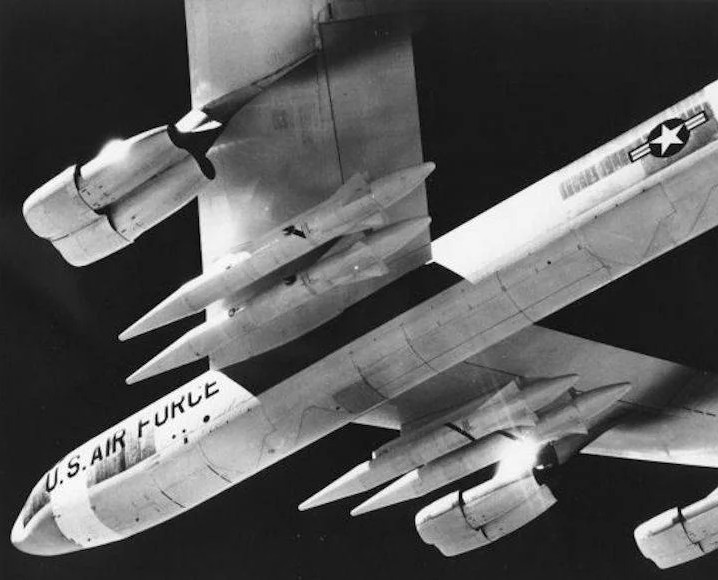 View from a different angle.
View from a different angle.
Regardless of the type of the carrier and the warhead, flight program promising missiles should look the same. Reset the product was carried out on the vehicle cruising speed at an altitude of several kilometers. Otdelivshisy the plane, it was supposed to "fall" on 120 m height, then resets and starts the tail fairing engine first stage. Immediately after the engine is switched on the rocket had to go climb at a predetermined angle. The engine worked for 100 from, after which the first step was separated and the second stage includes a motor.
With the help of the engines of both stages WS-138A missile was supposed to climb to a height of about 60 km. At the boost phase missile equipment determines the position and adjust the course. After lifting the rocket to a predetermined height and acceleration to speeds of the order 2,8 km / s, the second stage is turned off and discharged. Then the flight lasted only a combat unit. While firing at maximum range he could climb to a height of 480 km, and then began the descent toward its goal.
Shortly after the start of the project development company Douglas start full-scale aerodynamic testing. A platform for them became Eglin AFB (PC. Florida) and the nearest landfill. Model rocket WS-138A / GAM-87 were removed using regular carriers. In this case determined by their interaction with the aircraft and its influence on the characteristics. discharges layouts were also made with the collection of the necessary data. The first such test took place in January 1961 of the year, and testing continued the next few months. These checks allowed to improve the existing chassis and aerodynamic surfaces.
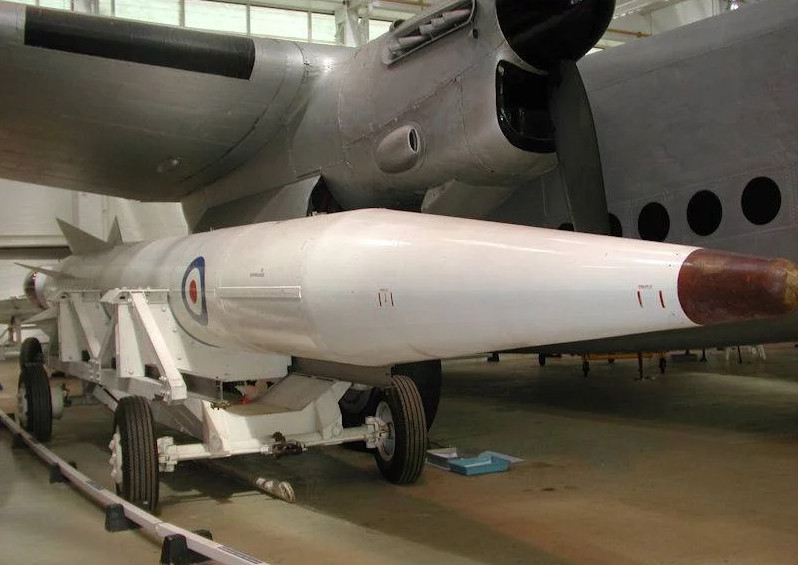 Layout Skybolt missile with British identification marks in the Royal Air Force Museum (g. Kosford).
Layout Skybolt missile with British identification marks in the Royal Air Force Museum (g. Kosford).
By the spring of next year, the project was ready to start full-fledged flight test. 19 April 1962 the aircraft B-52G dropped for the first time with the pylon XGAM-87 real rocket, on board which all standard equipment present, except the warhead. The rocket was supposed to fly in the direction of the Atlantic Ocean. The first stage worked properly, but when the engine ignition is the second failure occurred. The missile could not continue the flight, testers had to use her self-killer.
After an investigation of the accident and continued refinement test project. 29 June was the second reset. At this time, experienced a rocket could not start the engine of the first stage. In the third run 13 September engine involved, but denied control system. The missile has deviated from the set course, and 58 seconds of the flight to undermine it had to avoid falling outside the permitted area. 25 September fourth rocket used the first stage and including the second, but its engine is stopped prematurely. Flight of the calculated distance proved to be impossible. next run 28 November again ended with an accident. On 4 seconds of rocket flight lost contact with ground means, and it had to be destroyed.
22 December 1962 year rocket XGAM-87 Skybolt first performed a successful flight. With the sixth attempt experimental product could properly using both motor and withdraw inert warhead to the desired trajectory. During this test, the design characteristics were confirmed by the range and precision shooting with warhead W59.
However, by this time the fate of the project has been solved. United States military and political leadership no longer see any point in continuing the work. In this case, the administration of President John F. Kennedy found several reasons for the rejection of a new missile. Her fate could affect technical factors, economic, military and political.
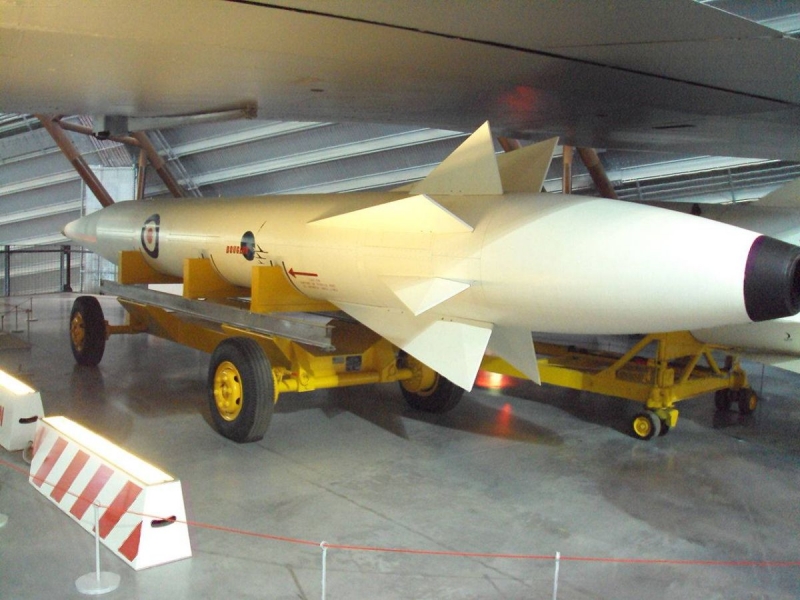 View of the rear fairing.
View of the rear fairing.
At first, GAM-87 rocket looked, to put it mildly, unsuccessful. Of the six test flights successfully completed only one. No one could say, when the rocket will show the required reliability, and what will be the total cost of the program. Besides, desired results were achieved in ballistic missiles for submarines, which could take on the tasks of the system Skybolt. Finally, after the recent Cuban missile crisis, Washington wanted to show his desire for peace, and it required significant renounce nuclear weapons in any project.
In this situation, WS-138A project / GAM-87 had no chance. In November 1962 , it was decided in principle to, a 22 December Dzh.F. Kennedy signed a decree on the termination of the development of new missiles aeroballistic. Ironically, it happened on the day the only successful trial run. However, works were not stopped. By this time the company Douglas and associated companies had to make a number of advanced missiles, and their planned use of new tests for the study of various issues.
The decision of the US leadership on the refusal of the further development of products GAM-87 outraged official London. Under the agreement, 1960 of the year, These missiles were to enter into service the Royal Air Force and become perhaps the most powerful of weapons. Refusal of development, in its turn, He has hit the prospects of British strategic nuclear forces. Countries were forced to start specific negotiations, the purpose of which was to develop new plans for joint development of the nuclear triad UK.
Dzh.F. Kennedy held talks with British Prime Minister Harold Macmillan, which resulted in the Pact was signed Nassau. In return, the US aircraft missiles Skybolt offered to supply products UGM-27 Polaris submarine. The preliminary agreement was confirmed by the contract 6 April 1963 of the year. Soon we began shipping missiles, thanks to which the United Kingdom was able to create the desired nuclear shield.
The known data, tests remaining in the presence of missiles WS-138A / XGAM-87 lasted for nearly all 1963 of the year. In June, the Pentagon has launched a new range missile, whereby Skybolt renamed AGM-48. Under the new name of the available missile performed several flights. During these tests have taken place and progress, and accident, but they no longer affect the outcome of the work. They study the various issues, but about the production of missiles into service it was not more than.
air-launched ballistic missile Douglas WS-138A / GAM-87 / AGM-48 / Skybolt could become the first example of its class, adopted by the US Air Force. However, the presence of trouble, be solved, alternative development and the political situation in the world has led to the abandonment of the project and the field as a whole. The new re-USAF Strategic Air Command, started soon, It was carried out using the cruise missiles.
On this Site:
http://designation-systems.net/
http://airwar.ru/
https://globalsecurity.org/
https://fas.org/
http://space.skyrocket.de/











